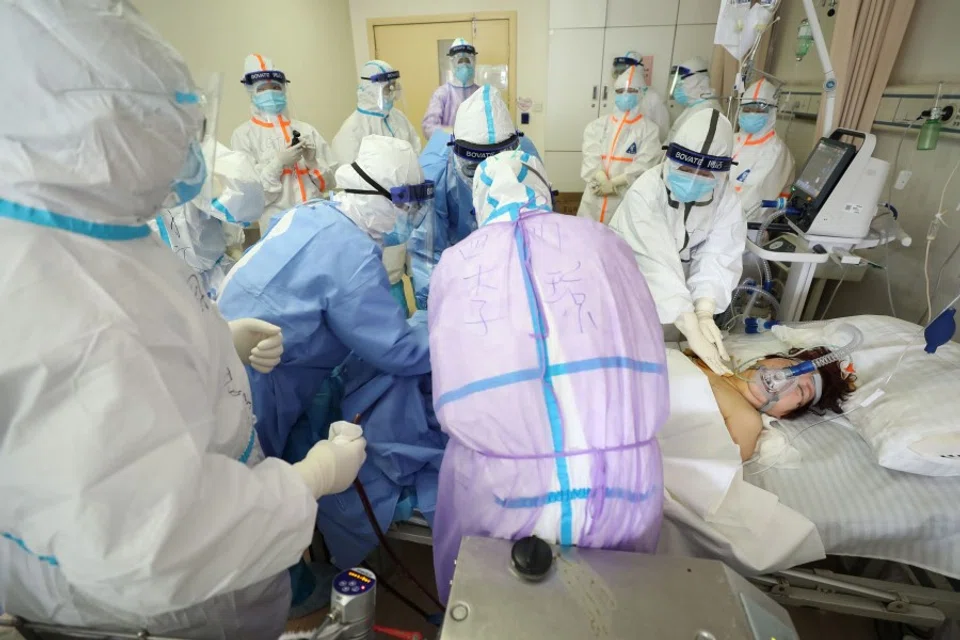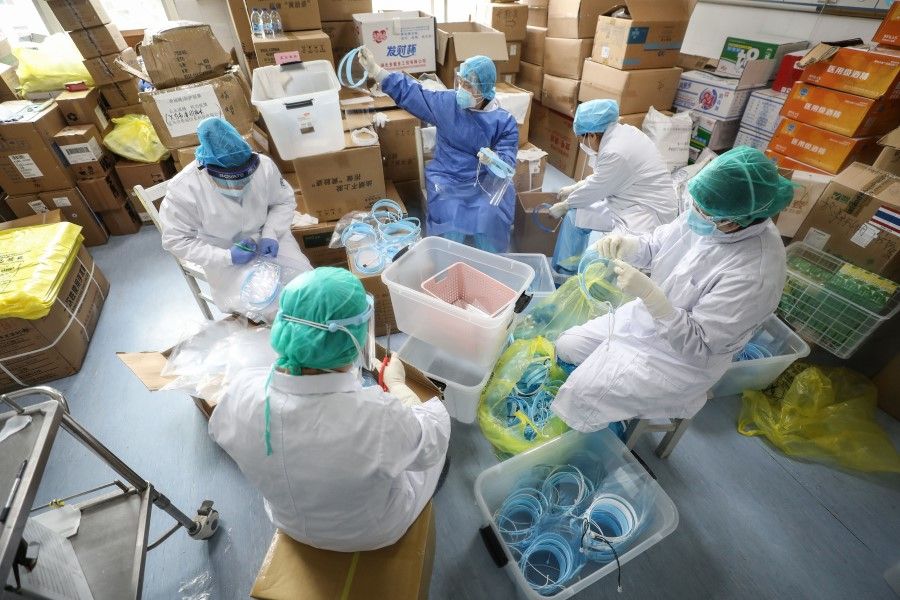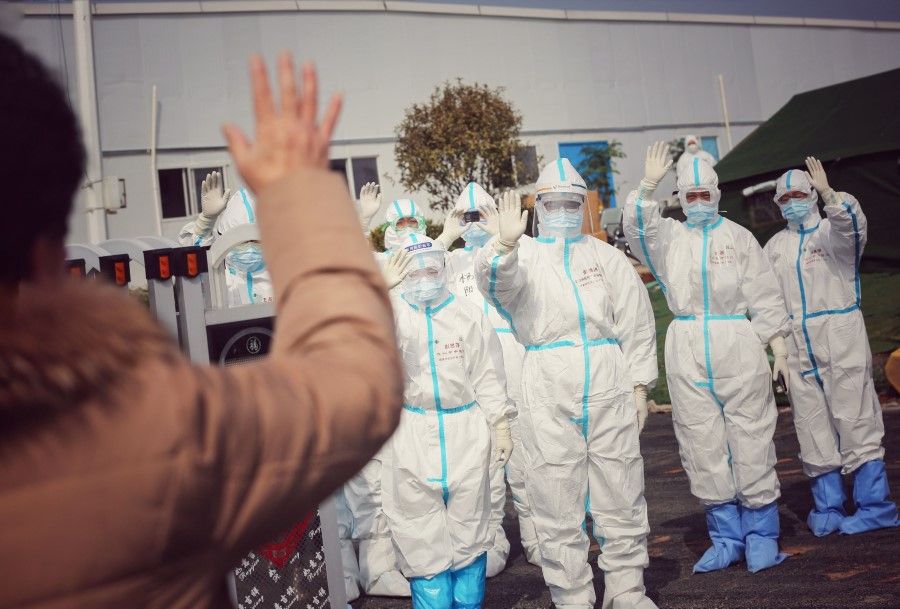China's public healthcare system needs a revamp

Like the combat against SARS years ago, the ongoing fight against Covid-19 is showcasing to the world the Chinese government's capabilities in deploying and allocating resources across the whole country. We have come to a clearer appreciation of a unified power rarely seen - that of the Chinese people when they stand as one to pull through a difficult time. However, the virus situation also exposes the deficiency of China's domestic public health facilities and their inadequate capacity to deal with emergencies.
...it would be very necessary to do some deep thinking about the building of public health facilities once the whole Covid-19 situation is over.
For a long time after the outbreak began, many of the infected in Wuhan were still waiting in long queues to get screened and diagnosed. Even when they were found to be confirmed cases, there was hardly any room in the hospitals for them to be admitted, so they ended up not receiving prompt treatment. Ultimately, they had no choice but to go home and quarantine themselves. For many, this resulted in the spreading of the disease to their family members, personal suffering as their condition worsened, and sometimes, even death.
As an emergency response, the Chinese government decided at some point to invest in the building of two hospitals - Huoshenshan and Leishenshan - in Wuhan, as well as to convert various existing facilities into mobile cabin hospitals. Although these measures managed to expand the supply of hospital beds as well as the capacity to take in and treat patients at short notice, we can only imagine the tremendous finances and human resources expended. Since building infrastructure in crisis mode is neither a considered nor economical approach, the costs involved must have been much higher as compared to less extraordinary times. Precisely because of this, it would be very necessary to do some deep thinking about the building of public health facilities once the whole Covid-19 situation is over.

Accelerate capacity building
Make no mistake, China's investment in public health capacity building has been rising in conjunction with the constantly increasing investment in infrastructure to improve people's livelihoods. While state funds invested in the public health sector only amounted to 3.544 billion RMB in 1978, the figure hit 1.6 trillion RMB after the 1970s. This represented an increase from the equivalent of about 0.9% of China's GDP to 1.7%.
This percentage (public health spending) was not only lower than the corresponding relative quantity for high income countries (their average figure being 8.1%), it also turned out to be the smaller amount in comparison with low-income countries (their average figure being 6.8%).
However, despite such a substantial jump, the Chinese government's investment in public health is actually equivalent to a rather small part of its GDP - only slightly higher than 1.5% - which is the average figure for low income countries. In contrast, the corresponding percentage is as high as 7% for developed countries and 4.5% for middle-income countries. Furthermore, in the case of China, the government's public health investment is not consistently on the rise. It dived to its lowest in 1995, for example, when it was equivalent to only 0.62% of the country's GDP. Its rate of growth is lower than that of the total investment in public infrastructure.
That the Chinese government's investment in public health is unsatisfactory is clear when we look deeper into the total national expenditure for the said sector. Data shows that the entire country's public health spending in 2018 was at a total of 5.7998 trillion RMB, equivalent to 6.6% of China's GDP. This percentage was not only lower than the corresponding relative quantity for high income countries (their average figure being 8.1%), it also turned out to be the smaller amount in comparison with low-income countries (their average figure being 6.8%).
More importantly, as we bear in mind that the total national public health expenditure consists of three components (i.e., the government's health expenditure, personal health expenditure and social health expenditure), the first component has been a dwindling piece of the pie year by year. In the last 10 years alone, the percentage taken up by the Chinese government's expenditure has dropped from 28.7% in 2010 to 28.3% in 2018. During this interval, the figure was no more than 30.66% at its highest, and generally on a downward trend. Of the country's total health expenditure, the government's spending - as outlined above - largely accounted for less than 30%, which was conspicuously lower than the 70% to 80% seen in major industrialised countries, and indeed not even comparable with the figure of 45% for emerging markets. In major industrialised countries like the US and Japan, the government's total health expenditure took up an average of 13% of the total government spending, and even reached 17% at its highest. But in China, the percentage was only 11%.
With the Chinese government providing medical insurance coverage over the last few years for serious illnesses and for rural residents, it is true that personal health expenditure in the country has gone down significantly. At its peak, it was 59.0% of the total public health expenditure. Now it has dropped to 28.7%. Meanwhile, social health expenditure has climbed to 43.01%, which indicates how strong the forces of commercialisation and marketisation are in connection to public health expenditure. However, as the experience of other countries shows us, in public health matters we should focus, first and foremost, on disease prevention - medical assistance comes after that.
Focus on prevention, not just treatment
In China, even though corporate spending on medical insurance for employees is constantly going up, and private hospitals constitute a steadily growing segment, the newly added finances and resources are not directed at disease prevention, but are entirely utilised on medical treatments instead.
...on one hand, China's medical facilities are growing in number by the year; on the other hand, the professional public health agencies are constantly shrivelling.
The expansion of private hospitals, in particular, alleviates the undersupply of social health facilities to some extent, yet the business operation of these hospitals is focused on cosmetic surgeries, beauty treatments as well as the handling of infertility and sex-related conditions. Not only are these hospitals unable to treat common diseases and critical conditions like their public counterparts can, but they are also basically powerless or totally unwilling to play any part in various public health functions, such as health education, nutritional intervention, immunity programmes, and the prevention and control of contagious or chronic diseases.

The truth is: even in China's public health institutions (especially the public hospitals), there is a tendency to focus on medical care services and neglect the aspect of prevention. Monetary amounts spent on individual healthcare (especially public-borne medical expenses) are constantly rising, while investment towards the protection of communities against diseases remains insufficient.
To make matters worse, the already limited funds and resources are often allocated to profit-oriented medical facilities, while the funds for some epidemic prevention agencies that are more public-oriented are dwindling. What results is a curious diptych of mutually opposite developments - on one hand, China's medical facilities are growing in number by the year; on the other hand, the professional public health agencies are constantly shrivelling.
The numbers say it all: at the end of 2018, China had a total of 997,434 healthcare institutions, 10,785 more than the previous year, yet the professional public health agencies had been reduced in number by 1,862. For any society, when the network of professional public health agencies (consisting of centres of disease prevention and control, centres of health promotion for women and children, etc.) is gradually shrinking, and when the disease prevention functions of the healthcare institutions that do remain are failing, it means that the entire public health system is getting weaker.
Correspondingly, various capabilities that radiate from the said system would be increasingly attenuated. These include the capabilities to improve fundamental public health conditions, ensure the quality of drinking water, optimise the environments for food and beverages consumption, prevent and control contagious diseases, and conduct health education for the populace.
... there exist backward notions about public health consumption, which see public health expenditure as a kind of welfare consumption or even a consumptive expenditure, rather than a kind of investment in human capital.
Notably, economic theory tells us that public health services exhibit a very strong positive externality. For example, a coronavirus patient cured means lowered chances for other members of the society to be infected. This is why the public coffers must determinedly bear the cost of treating the novel coronavirus. We can easily understand that the government alone has to play the central role in public health investment and capacity building. We must not pin our hopes on any commercial entity for this.
But why has the Chinese government not been investing enough in public health? A comprehensive analysis reveals two underlying factors. One of these is that there exist backward notions about public health consumption, which see public health expenditure as a kind of welfare consumption or even a consumptive expenditure, rather than a kind of investment in human capital. Another factor is that, under the current tax-sharing fiscal system, there is an asymmetry between the central and the local governments in terms of both financial and executive powers. It is the local governments that are mainly responsible for health expenditures. Given that the funds available to them are very limited, public health developments between the cities and the rural areas, as well as between different localities in general, become imbalanced.
Healthcare as human capital
In any case, it must be stressed that step-ups in public health investment can piggyback entirely on the economic growth brought about by the ripple effect from the relevant industrial chain. Past experiences show that only about 30% of the financial investment in infrastructures like railways and roads would be translated into part of the GDP of the year, whereas about 60% to 70% of the investment in public services and facilities (like those related to education, health and culture) could be translated thus. In other words, the same monetary amount has a higher investment efficiency and gives the GDP a stronger boost when pumped into the public health sector.
Equipped with such protection, a country or city would be better fortified from the ground up to deal with any threat, and not collapse even when it finds itself in a grave situation.
In addition, health stands alongside education as one of the two major cornerstones of human capital. It is the basis for personal learning ability and productivity, not to mention one's intelligence, physical strength, as well as capacity for emotions and juvenile development as an individual. To invest in public health is therefore to invest in well-being - that is to say, human capital. Such investments will boost productivity and corporate outputs, and bring about the stable growth of national fiscal revenue.
One thing to be made clear is this: the prime objective of public health is not about profit-making but the public good. For this reason, even though we may end up with idling resources when we increase the number of public health facilities and hospital beds to an adequate level and hire more public health professionals, we must look at how these additions will help in the long run and for the overall situation: they will ensure that our social fabric is strong.
Not only will the additions mark an upgrade in the government's public support capabilities, they shall also serve as a sturdy barrier for the country to isolate and interdict major public health disasters. Equipped with such protection, a country or city would be better fortified from the ground up to deal with any threat, and not collapse even when it finds itself in a grave situation. Only then shall the lives of its people and the national economy itself not be deeply harmed or grievously battered by any runaway catastrophe.

In view of the foregoing, within the five years covered by the 14th Five-Year Plan from 2021-2025, it will be entirely necessary for China's governance network - from the central government down to the local governments - to deploy the equivalent of 200 to 300 billion RMB to remedy the glaring shortcoming of the whole country's public health system. The central government should be responsible for the main thrust of public health investment.
To this end, China's central financial authorities may secure financing by issuing national public health bonds or public health lottery tickets, have the local governments issue their own public health-related special bonds on a larger scale than before, and attract the introduction of social capital packages through public-private partnerships (PPP) and other means.
With the increased finances on hand, we must ensure that more gets allocated to the hospitals and public health institutional infrastructure. On the basis of this reprioritisation, we will also need to focus the investment on establishing a sturdy public health emergency management system on the national and local level. Buttressed by multiple supports, the system is to encompass various facets, including disease prevention and control, major epidemic response, medical insurance, medical assistance, and the steady availability of emergency supplies.
